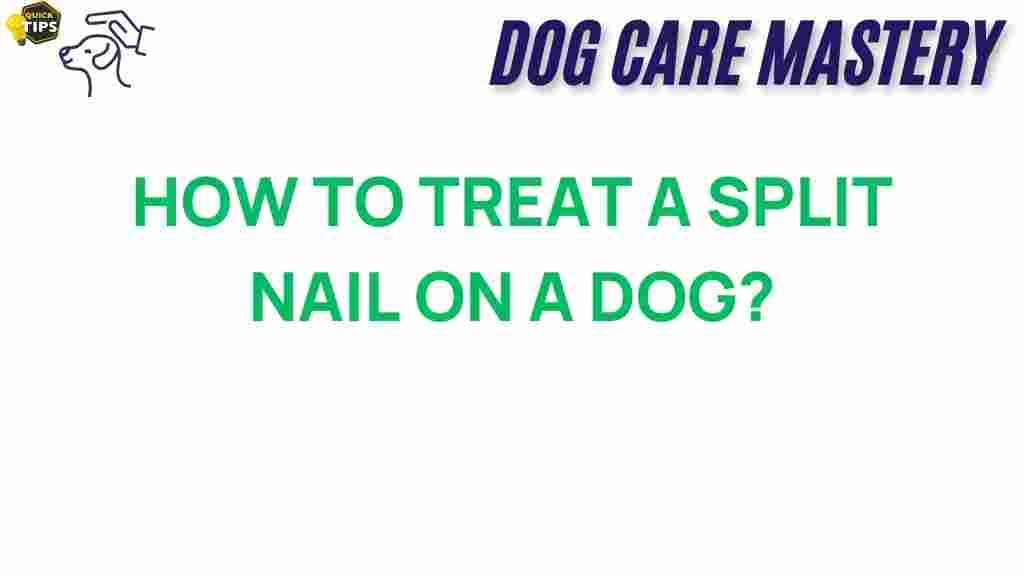Expert Tips for Treating a Split Nail on Your Dog Safely
Seeing your beloved dog in pain is never easy, especially when it comes to something as seemingly minor as a split nail. A split nail can cause discomfort, bleeding, and even infection if not treated properly. Fortunately, with the right approach, you can help your furry friend heal safely and effectively. In this article, we will provide expert tips on how to treat a split nail on your dog, ensuring that the process is as smooth and stress-free as possible.
Understanding Split Nails in Dogs
A split nail occurs when the hard outer layer of a dog’s nail cracks or breaks. This condition can arise due to various reasons, including:
- Improper nail trimming
- Excessive wear and tear from outdoor activities
- Underlying health issues
- Dry or brittle nails due to lack of moisture
It’s essential to recognize the signs of a split nail, which may include:
- Visible cracks or splits in the nail
- Bleeding or oozing from the nail bed
- Pain or sensitivity when pressure is applied
- Reluctance to walk or play
Step-by-Step Process for Treating a Split Nail
Treating a split nail requires careful attention and a calm approach. Here’s a step-by-step guide to help you through the process:
Step 1: Assess the Damage
Before taking any action, carefully examine your dog’s paw to assess the extent of the split nail. Check for:
- How deep the split goes
- Whether there is any bleeding
- Signs of infection (redness, swelling, or pus)
Step 2: Gather Your Supplies
You will need the following supplies:
- Dog-safe antiseptic solution
- Gauze pads or clean cloth
- Bandage or medical tape
- Dog nail clippers (if trimming is necessary)
- Treats to reward your dog
Step 3: Clean the Affected Area
Gently clean the split nail with a dog-safe antiseptic solution to prevent infection. Avoid using hydrogen peroxide, as it can be too harsh and may slow the healing process.
Step 4: Trim the Nail (if necessary)
If the split nail is long and jagged, you may need to trim it carefully. Use dog nail clippers and cut just above the split to avoid further injury. If you are unsure, it’s best to consult a veterinarian.
Step 5: Bandage the Nail
Wrap the split nail with a gauze pad and secure it with medical tape. Ensure it’s snug but not too tight, as this can restrict blood flow.
Step 6: Monitor for Healing
Keep an eye on the bandaged area and change the dressing daily or if it becomes wet or dirty. Look out for any signs of infection, such as increased redness or swelling.
Troubleshooting Tips for Split Nails
Even with careful treatment, complications can arise. Here are some troubleshooting tips to keep in mind:
What If the Nail Continues to Bleed?
If you notice persistent bleeding, apply gentle pressure with a clean cloth or gauze. If bleeding does not stop within 10-15 minutes, contact your veterinarian.
What If My Dog Is in Pain?
Observe your dog’s behavior. If they appear to be in pain despite treatment, consider giving them a dog-safe pain reliever as recommended by your veterinarian.
When to Seek Veterinary Care
In some cases, a split nail may require professional attention. Contact your veterinarian if you notice:
- Severe bleeding that does not stop
- Signs of infection
- Excessive pain and discomfort
- A fractured nail that requires surgical intervention
Preventing Future Split Nails
To help prevent split nails in the future, consider these tips:
- Regular Nail Trimming: Keep your dog’s nails trimmed to an appropriate length to reduce the risk of splits.
- Moisturize the Nails: Use a dog-safe moisturizer to keep your dog’s nails hydrated and less prone to cracking.
- Avoid Rough Surfaces: Limit your dog’s exposure to rough or abrasive surfaces that can wear down their nails.
- Provide a Balanced Diet: Ensure your dog is receiving a balanced diet rich in vitamins and minerals to support healthy nail growth.
Conclusion
Treating a split nail on your dog can be a straightforward process if approached with care and caution. By following the steps outlined in this article and keeping an eye on your dog’s recovery, you can help them heal safely and comfortably. Remember that prevention is key, so be proactive in keeping your dog’s nails healthy and well-maintained. If you have any concerns or if the condition worsens, don’t hesitate to reach out to your veterinarian for assistance.
For more information on pet care and health, visit your local vet’s website. You can also find useful resources on pet care at the American Kennel Club.
This article is in the category Grooming and created by dogcaremastery Team
